The obesity epidemic is not just growing, it is exploding. Over 40% of U.S. adults now meet criteria for obesity, and nearly 70% are overweight or obese. Recent estimates suggest that more than 1 in 4 American adults, approximately 80 million people, could be clinically eligible for GLP-1 medications like Semaglutide or Tirzepatide, based on BMI and metabolic comorbidities.
Yet, despite the clinical promise of GLP-1s and broader obesity interventions, the real question is not just who could be treated, but who should, and who actually would, given our current healthcare infrastructure.
Primary care is already at capacity.
The average primary care physician manages a panel of over 2,000 patients, and many are experiencing burnout at record levels. The U.S. faces a worsening shortage of primary care providers, with more than 83 million people living in areas with primary care access shortfalls. Expecting already overloaded PCPs to add intensive obesity care, which requires education, behavior change support, medication management, and longitudinal follow-up, is unrealistic without fundamentally changing the delivery model.
Obesity care is not a one-person job. It is multidisciplinary by nature: physicians, dietitians, health coaches, behavioral therapists, pharmacists, and care coordinators all have critical roles to play. But in today’s model, such comprehensive care only happens within tightly-knit systems , integrated health systems, brick-and-mortar clinics, or closed telehealth platforms, where the entire care team is under one roof or one app. Outside of these, the most common approach is still the “referral roulette,” where patients are bounced from one siloed specialist to another, often with long wait times and fragmented care.
So how do we scale effective obesity care beyond these walls?
The answer may lie in asynchronous, tech-enabled, provider-driven models. Imagine care teams that do not have to meet in real-time to be effective. Imagine a PCP who prescribes a GLP-1, and then loops in a health coach, a registered dietitian, or a behavioral therapist, asynchronously, through shared care plans, digital tools, and intelligent workflows. Not everyone needs to be on the same Zoom call or in the same building to be on the same team.
This is not just a futuristic concept. Forward-thinking health systems and providers are already opening “metabolic service lines”, digitally powered, protocol-driven programs that leverage their existing staff in smarter ways. By training and integrating nurses, pharmacists, health coaches, and medical assistants into asynchronous care pathways, supported by technology platforms, these systems can reach more patients, reduce PCP burden, and improve outcomes.
This is the perfect use case for AI-enabled human care, where technology augments, not replaces, the care team. It creates the scale, consistency, and personalization we desperately need, while protecting the human connection that patients trust.
When deployed thoughtfully, this model not only treats obesity but also changes how chronic care is delivered overall.
Time is here to unite the ecosystem, not by asking PCPs to do more, but by designing systems that allow them to do less, more effectively. The right combination of tech infrastructure, clinical leadership, and care team redesign can turn obesity care into a scalable, sustainable service, not a luxury.
So, the next time we ask, “Who could treat obesity?”, the real answer is, we all could. But only if we build it differently.
Join FusionCare AI in getting involved with Obesity Care.













